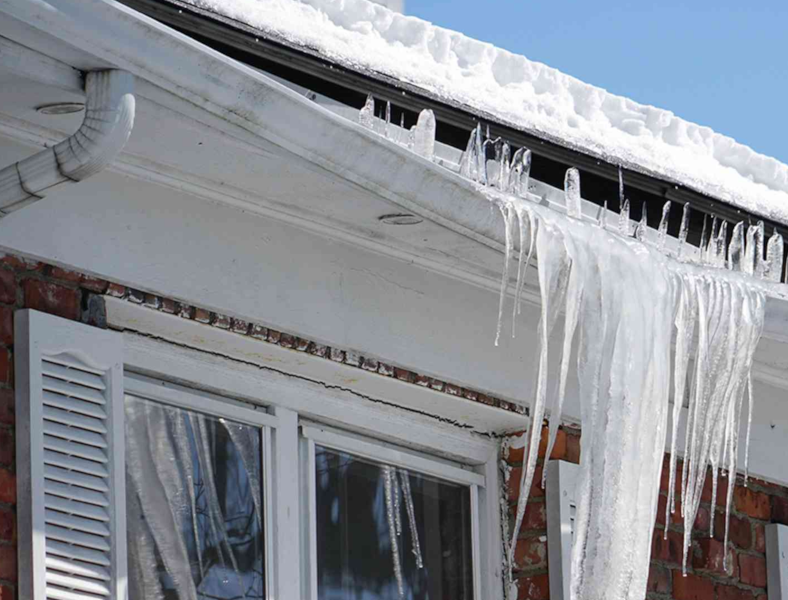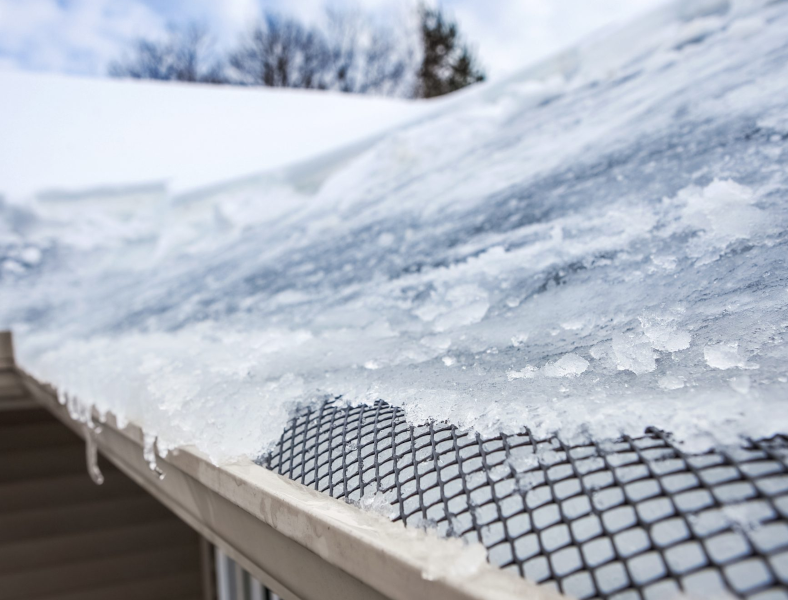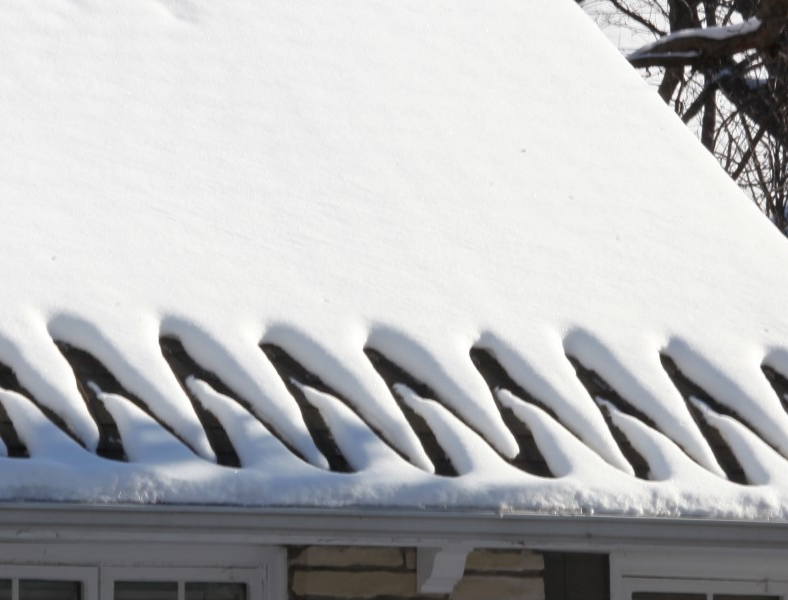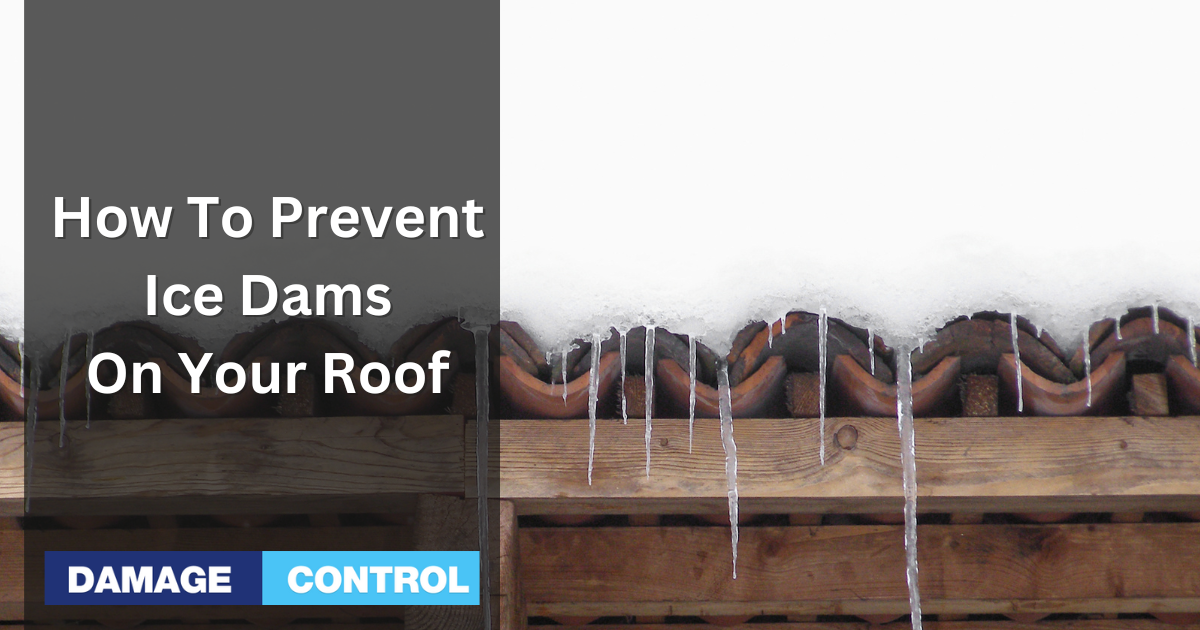Ever had an ice dam on your roof? If you're scratching your head wondering what in the world I'm talking about, no worries. An ice dam is this pesky build-up of ice that forms at the edge of your roof in winter. It prevents the snow from melting and draining off your roof.
Instead, the water backs up behind the dam, where it can leak into your home and cause all sorts of trouble – think peeling paint, warped floors, stained ceilings – you get the picture, right?
Now, here's the deal. Ice dams are not just a minor annoyance. Neglecting them can lead to costly repairs, not to mention they can be a safety hazard too. It's crucial to address them promptly, to save you both time and money. Stick with me, and I'll guide you through the ins and outs of eliminating and preventing ice dams on your roof. You got this!
What are the Red Flags that Signal Ice Dams?

Ice dams can be sneaky, but they're not exactly secret agents. They leave behind clues that can tip you off. Let's dig into what you should keep an eye out for.
Icicles Hanging from Eaves: Pretty or Problematic?
You bet they can be problematic! Those icicles hanging from your eaves might look like they belong on a holiday greeting card, but they're usually a sign that an ice dam is lurking. If you see these icy stalactites forming, it's time to get your detective hat on.
Is Ice Buildup on Roof Edges a Big Deal?
Oh, you bet it is. Ice buildup on roof edges is another dead giveaway. If your roof edges are starting to resemble an Arctic panorama, it's a safe bet you're dealing with an ice dam. It's like your roof is sending you an SOS!
Water Stains or Damage Inside Your Home: A Sign?
Bingo! If you're noticing water stains or damage on your ceilings or walls, it's time to pay attention. These telltale signs inside your home are like an ice dam's calling card. They're saying, “Hey, we're here and we're causing trouble!”
Remember, knowledge is power, friends. Spotting these red flags early can help you address ice dams before they cause major damage. So, keep your eyes peeled and don't let those sneaky ice dams catch you off guard!
What's the Big Deal If You Ignore Ice Dams?
Ignoring ice dams is like ignoring a ticking time bomb, only it's chilly and it hangs out on your roof. Let's explore why turning a blind eye is a bad idea.
Can Ice Dams Really Damage Your Roof?
Yes siree, they can! Ice dams can cause significant roof damage. They can mangle your shingles and even mess with the underlying structure. It's like inviting a bull into a china shop, but the bull is cold and lives on your roof. Not a fun party, trust me.
What's the Story with Water Leaks and Interior Damage?
Got it in one! That dam is holding back a bunch of water that's just itching to sneak into your home. When it does, it can cause all sorts of headaches, from peeling wallpaper to stained ceilings. It's like the world's worst surprise party, courtesy of your icy roof.
Are There Safety Hazards from Falling Ice?
Oh yes, and this one's a doozy. Those gorgeous icicles can morph into dangerous projectiles if they fall. Always be aware of this potential hazard. It's like your roof is playing a game of “drop the icicle,” and you definitely don't want to be the one it lands on!
In short, don't treat ice dams like unwanted guests you can just ignore. They're more trouble than they're worth. And remember, the best defense is a good offense!
What's the Science Behind Ice Dams?
Ice dams aren't just winter's way of playing a prank on you. There's real science involved. So let's put on our lab coats and get into the details.
Temperature Fluctuations: The Puppet Master of Ice Dams?
Imagine temperature fluctuations as the big boss behind ice dams. It's all about the seesaw of warm and cold. When the upper part of your roof gets a bit warm, the snow up there says, “Hey, let's melt!” But hold up. The lower part of your roof? It's still in chill mode. So, when the melted snow hits the colder area, it pulls a U-turn and freezes again. Just like that, you've got yourself an ice dam. Pretty cool, huh?
Snow Accumulation and Melting: The Building Blocks?
Snow is like the ice dam's bread and butter. No snow? No ice dam. When snow piles up on a warm roof, it melts and starts a downhill journey. It's like a mini river running down your roof. But then – plot twist – it hits the colder edge of the roof and freezes, forming an ice dam. It's a classic case of freeze, thaw, repeat!
Does Roof Design and Insulation Have an Impact?
You bet! Your roof design and insulation can either invite ice dams to the party or show them the door. Think of insulation as your roof's winter jacket. If it's good quality and fits just right, it keeps your roof evenly cold and helps prevent snow from melting and refreezing. And your roof design? It can help or hinder snow accumulation. Complex roof designs with lots of valleys and crannies can encourage ice dams to set up shop.
So there you have it, the science of ice dams – a blend of temperature seesaws, snow journeys, and roof fashion. And remember, understanding the enemy is the first step to victory!
How Does Roof Design and Insulation Impact Ice Dams?
Great question! Your roof design and insulation can either invite or deter ice dams. Poor insulation can lead to more heat loss, warming up your roof and melting the snow. Meanwhile, a complex roof design with lots of nooks and crannies gives ice dams plenty of places to form. It's all a chilly, icy dance!
How Do You Banish Existing Ice Dams?
Got an ice dam staring you down? Don't worry, we've got this. Here's how to show it the door.
Can You Use a Roof Rake to Remove Ice Dams?
Absolutely! A roof rake with a long handle can be your best friend in this battle. Use it to pull down snow from the roof, reducing the raw material for your ice dam. Just be careful not to damage your shingles.
Does Calcium Chloride Help?
Spot on! Calcium chloride, a type of ice melt, can be your secret weapon. Fill a leg of an old pair of pantyhose with it, and place it vertically across the ice dam. It'll melt a channel in the dam, allowing water to drain off your roof.
Can You Use Hot Water to Melt Ice Dams?
Absolutely! Hot water can swoop in like a superhero and melt through the ice dam, making an escape route for the water. Imagine it like creating a mini river through that icy dam on your roof.
But here's the catch. This isn't a permanent solution. It's more like putting a band-aid on a cut – it helps for a bit, but it's not going to heal the underlying issue. The hot water trick is a quick fix, a way to buy yourself some time.
Remember, hot water is just treating the symptom – the ice dam – not the cause, which is a mix of insulation issues, roof design, and snow accumulation. It's like taking a painkiller for a headache caused by dehydration. Sure, the painkiller might help with the headache, but you're going to need to drink some water to solve the problem.
Also, keep in mind that using hot water to melt ice dams should be done with care. You don't want to end up causing more harm than good. There's a risk of injury from the steam, or damage to your roof or gutters from the sudden change in temperature.
So, while hot water can be a quick solution when you're in a pinch, it's not a long-term fix. For that, you'll need to address the underlying issues causing the ice dams in the first place. But hey, it's always good to have options, right?
When Should You Wave the White Flag and Call a Professional for Ice Dams?
Well, there are a few scenarios where it's best to put down the roof rake and pick up the phone. Let's dive into them.
Is it Safe to Tackle Ice Dams Yourself?
Safety first, folks! A roof layered with snow and ice can be as slippery as a banana peel. Climbing up there without the right equipment or experience is like playing roulette with gravity. I don't know about you, but that's a game I'd rather not play. If you're not 100% confident, it's time to call in the cavalry – the professionals.
What if Your Roof is as Complex as a Maze?
Some roofs are straight-up architectural wonders, with more twists and turns than a roller coaster. If your roof has a complex design, complete with lots of corners, valleys, and steep slopes, ice dam removal can feel like navigating a labyrinth. In such cases, it's safer and more efficient to let a pro handle it. They're trained to work with all kinds of roof structures, and they'll know the best way to tackle those tricky spots.
Are Ice Dams Making a Comeback on Your Roof?
If ice dams are reappearing on your roof like unwanted pop-up ads, it's a sign of a deeper issue. It could be poor insulation, inadequate ventilation, or other structural issues. Persistent ice dams need a more thorough approach. That's where a professional can step in. They'll play detective, find the root cause, and help you fix it for good.
The bottom line is if you're unsure or uncomfortable, don't hesitate to call a pro. They're equipped to handle ice dams safely and efficiently. Remember, your safety and your roof's health are most important. Be like a boy scout – be prepared, be safe!
How Can You Keep Ice Dams from Crashing Your Winter Party?
The secret to a carefree winter? Prevention, my friends. Let's dive into how you can keep those icy intruders at bay.
How Does Attic Insulation Play a Role in Preventing Ice Dams?
Think of attic insulation as your home's cozy winter hat. It keeps the warmth where it belongs – inside, not escaping to the roof. Better insulation means less heat loss, reducing the chance of rooftop snow melting and refreezing into an ice dam. So, yes, upgrading your attic insulation can be a game-changer in your battle against ice dams.
What are Your Choices When it Comes to Insulation Materials?
Choices, choices! Insulation materials come in all shapes and sizes. You've got your traditional fiberglass batts, the fluffy pink stuff you might picture when you think of insulation. But there's also cellulose, a plant-based material that's often sprayed into place. There are even foam insulations, like polyurethane, that can really up your insulation game. Your ideal choice depends on factors like your home's design and your local climate. It's like shopping for a winter coat – you've got to find the right fit!
What's the Best Way to Install Insulation?
Insulating your attic is not a slapdash job. You need to be meticulous. Make sure there are no gaps or thin spots in the insulation. Think of it like laying a carpet – it should cover the entire attic floor, and it should be uniform in thickness. Every nook and cranny counts, so pay attention to detail. It's one of those tasks where doing it right the first time can save you a world of trouble down the line. So, take your time, do it right, and your roof will thank you!
Does Proper Attic Ventilation Make a Difference?
You bet it does. A well-ventilated attic helps keep your roof cold, stopping snow from melting and forming ice dams.
Can Soffit Vents Help?
Definitely. Soffit vents allow cold air to enter the attic, balancing out any heat that escapes from below.
What About Ridge Vents?
Ridge vents are the exit doors for hot air. Located at the peak of your roof, they allow warm air to escape, keeping your attic and roof cooler.
And Gable Vents?
Gable vents, located on the ends of your house, can also help circulate air in the attic.
How Does Roof and Gutter Maintenance Fit In?

Maintenance is key, folks. A well-cared-for roof is less likely to host an ice dam party.
Why Should You Get Regular Roof Inspections?
Roof inspections can spot potential ice dam breeding grounds. An expert can identify issues and help you address them early.
Why is Cleaning and Repairing Gutters Important?
Clean, well-maintained gutters allow water to flow off your roof, instead of sticking around and freezing into an ice dam.
Should You Address Roof Damage Promptly?
Absolutely. Damaged roofs can exacerbate ice dam formation. Fix any issues as soon as you spot them. Your roof will thank you!
Which Roofing Materials and Designs Can Keep Ice Dams at Bay?
Choosing the right materials and designs for your roof can help you say “no thanks” to ice dams. Let's explore some options.
Is Metal Roofing a Good Idea?
Absolutely! Metal roofs are like a non-stick pan for snow. It just slides right off, leaving no chance for an ice dam to form. Plus, they're durable and long-lasting.
What's a Cold Roof Design?
A cold roof design is all about keeping the entire roof the same temperature. This design features above-deck insulation and ample ventilation to keep the roof cold, preventing snow from melting and refreezing.
Can an Ice and Water Shield Help?
You bet! An ice and water shield is a type of underlayment that goes under your roofing material. It forms a waterproof barrier, preventing any water from an ice dam from sneaking into your home.
Choosing the right roof can be a game-changer in your fight against ice dams. So, consider your options and pick what works best for you and your home. Remember, an ounce of prevention is worth a pound of cure!
Can Heating Solutions Keep the Ice Dams Away?

Yes siree! Just like a warm cup of cocoa can ward off the winter chill, a little heat in the right place can help fend off those icy invaders. Let's explore a couple of these toasty tools.
Can Heated Cables Kick Ice Dams to the Curb?
You betcha! Think of heated cables as your roof's personal sunbeam. They zigzag along your roof edge, gently warming it up to keep ice at bay. Prices can range from $50 to $200, depending on the length you need. And the beauty? They're pretty simple to install. Just clip them on, plug them in, and watch them work their magic. But, remember, they use electricity, so you're going to see a small bump in your power bill.
Are Infrared Heat Panels a Good Defense Against Ice Dams?
Indeed, they are! Infrared heat panels are like having a little piece of summer on your roof, even in the dead of winter. These nifty gadgets emit heat that can melt snow before it even thinks about becoming an ice dam. They're a bit more of an investment, typically costing several hundred dollars. However, their ease of use and effectiveness can make them worth the splurge. Plus, they're pretty low-profile, so they won't cramp your home's style.
Bottom line? Heating solutions can be a powerful ally in your fight against ice dams. So, consider warming up your roof to keep those frosty foes at bay. Trust me, your wallet will thank you when you avoid the hefty cost of ice dam damage. Now that's a hot tip!
How Can You Prepare for Winter Weather to Avoid Ice Dams?
Winter is coming, folks, and it's bringing ice dam conditions with it. But don't worry, here's how you can stay ahead of the game.
What are Some Snow Removal Strategies?
Have a roof rake on hand to remove snow after each snowfall. It's a simple step, but it can make a big difference. Remember, less snow means fewer ice dams.
Why Should You Monitor Weather Forecasts?
Keeping an eye on the forecast can alert you to potential ice dam weather. If a snowstorm is on the way, you'll know it's time to prep your roof.
How Can You Be Proactive During Snowstorms?
While the snow is falling, keep an eye on your roof. Take action if you see a lot of snow accumulating, especially near the eaves. Use your roof rake or call a professional to prevent ice dam formation.
Getting ready for winter weather is crucial to avoid ice dams. So, stay alert, keep your roof clear, and watch out for those sneaky ice dams.
Got Questions? We've Got Answers!
Ice dams can be confusing, but we're here to help. Let's tackle some of your most burning questions.
How Can I Tell if I Have an Ice Dam?
Seeing icicles hanging from your eaves? Or maybe a wall of ice at the edge of your roof? You might have an ice dam. Inside, look for water stains or damage on ceilings or walls.
Can I Use Salt to Melt the Ice on My Roof?
Yes, but use calcium chloride, not rock salt. Rock salt can damage your roof and plants. Fill a pantyhose leg with calcium chloride and place it across the ice dam to melt it.
How Do I Know if My Attic is Well-Insulated?
Your attic is probably well-insulated if it stays cold in winter, hot in summer, and you don't have ice dams. To be sure, an energy auditor or insulation professional can check for you.
What Should I Do if I Find a Leak Caused by an Ice Dam?
First, try to remove the ice dam or create a channel for water to escape. Then, get the leak fixed promptly to prevent further damage. If you're unsure, call a pro.
How Much Does It Cost to Have a Professional Remove Ice Dams?
On average, professional ice dam removal costs between $300 and $600, depending on the size and complexity of the job. But remember, that's a lot cheaper than fixing water damage inside your home!
Hope that clears up some of your ice dam queries. Remember, it's always okay to call in a professional when in doubt. They're there to help!
Conclusion
You've now armed yourself with knowledge about ice dams and how they can wreak havoc on your home's roof. But the journey doesn't stop here. In fact, there's so much more to discover about maintaining the health and longevity of your home's roof.
We have an article on how to clean the grime off your roof, as well. Once your roof is squeaky clean, you might want to give it a fresh coat of paint to enhance its appeal.
Or maybe you need a sealant for a different roof material. Our Metal Roof Sealants: Your Ultimate Guide is a great place to start if you're considering a metal roof. And if you're torn between shingles and tiles, our comprehensive comparison, Roof Shingles vs. Tiles: Ultimate Guide for Homeowners, will definitely shed some light on the best option for your home.
Finally, if you're located in the Orlando area and need professional services for any kind of water damage, don't hesitate to reach out to Damage Control 911: Orlando Water Damage Pros. We're always here to help. Remember, the more you know, the better prepared you'll be to protect your home from potential damage. So don't stop learning, and let's keep our homes safe, together.

